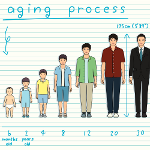
“That’s a good question,” says Allan Reese, an independent statistical consultant (and a member of the Significance editorial board). “Average life expectancy continues to grow in most countries. Infectious diseases are now avoided through removing the cause or by vaccination, and others can be cured. Cancers and other physiological conditions may be controlled or cured, but ‘cured’ is often defined as survival for 5 years. There are also many lifestyle choices that individuals can make to add or subtract from their individual life expectancy.”
But finding ways to live a little longer is not the same as living forever. “To live forever requires an increase in the maximum lifespan, not just the average,” says Reese, adding that while an increase in the number of centenarians has been widely trumpeted, “it is not obvious that there has been an increase in the maximum age a human can live to be.”
It’s hard to say exactly how long a human might live for without knowing how medicine and technology might evolve in future. One branch of statistics, extreme value theory (EVT), can provide an answer of sorts, given what we currently know about human life expectancy. EVT deals with the very large or very small values that lie at either end of a probability distribution, says Dr Emma Eastoe, a lecturer in the department of mathematics and statistics at Lancaster University. But EVT cannot predict wholly new developments that change the distribution, what philosophers term “paradigm shifts”.
A number of researchers have looked to apply EVT to the subject of human lifespan, including Aarssen and de Haan (1994), who used mortality data from the Netherlands to conclude that there is a finite age limit and that a 95% confidence interval for that age limit is 113–124 years.
To date, no one has exceeded the upper bound of that confidence interval – the oldest person on record being Jeanne Louise Calment of France, who died in 1997 at the age of 122 years and 164 days. Indeed, a preliminary study of age at death data in the UK, conducted by Eastoe, suggests that the highest attainable age has not varied much since 1961, when the figure for males was 112 years (95% CI: 109–115) and for females 110 years (109–111). For 2011, the equivalent ages were 111 years (110–112) for males and 108 (108–109) for females.
However, Eastoe notes that the probability of reaching age 90 has increased markedly over the same period. In 1961, for example, 15,157 females died at 90 or above; this corresponds to 5.59% of all deaths that year. In 1981 the equivalent figure was 30,456 (10.5% of deaths) and by 2011 it was 63,782 (25.5% of deaths). Male deaths over 90 show a similar pattern, but with smaller numbers attaining these higher ages.
So, yes, increasing numbers of humans are living longer now than in the past. But will we one day live forever? At this point in time, it seems unlikely.
What is 'Ask a statistician'?
A new regular column appearing in print and online in which we invite statisticians to answer burning questions put to them by members of the public. Our next question is:
The twentieth century witnessed two of the bloodiest conflicts in human history, so what are the chances that World War III will occur this century?
- Have an answer? Send it to significance@rss.org.uk, with the subject line “A statistician responds”.
- Have a question? Send it to significance@rss.org.uk, with the subject line “Ask a statistician”.




